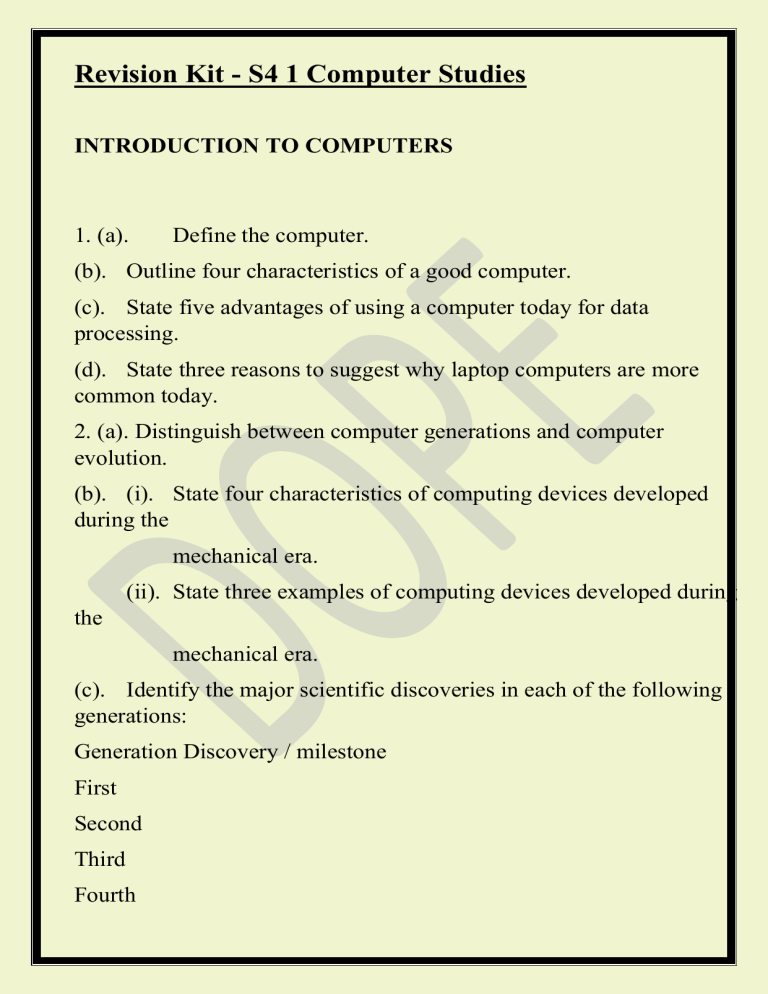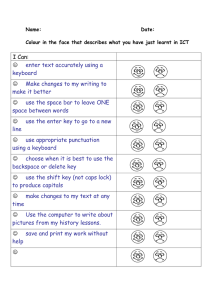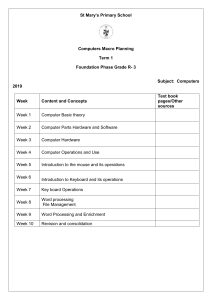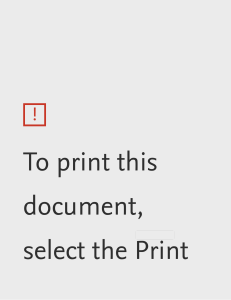
Revision Kit - S4 1 Computer Studies INTRODUCTION TO COMPUTERS 1. (a). Define the computer. (b). Outline four characteristics of a good computer. (c). State five advantages of using a computer today for data processing. (d). State three reasons to suggest why laptop computers are more common today. 2. (a). Distinguish between computer generations and computer evolution. (b). (i). State four characteristics of computing devices developed during the mechanical era. (ii). State three examples of computing devices developed during the mechanical era. (c). Identify the major scientific discoveries in each of the following generations: Generation Discovery / milestone First Second Third Fourth Fifth 3. (a). State three bases for classifying computers. (b). Give four characteristics of second generation computers. (c). use: Explain the following terms as used in relation to computer (i). Versatile. (ii). Diligent. (iii).Automation. (iv). Garbage - in, Garbage - out. (v). Artificial intelligence. (d). Give four disadvantages of using computers for data processing. 4. (a). State any three ways computes have caused unemployment in Uganda. (b). List four characteristics of first generation computer. (c). State any four examples of computers classified under / as personal computers. (d). Give three advantages that were associated with the development of the integrated circuit. 5. (a). computers: State four characteristics of the following forms of (i). Super computers. (ii). Mini - computers. (iii). Mainframe - computers. (iv). Micro - computers. Revision Kit - S4 2 Computer Studies (b). List three features of third generation computers. 6. Outline five practical uses of computers in each of the following sector areas: (i). Security. (ii). Governance. (iii). Education.ee (iv). Transport. (v). Entertainment. (vi). Military. (vii).Business. 7. (a). Define the term computer system. (i). (ii). Outline any five elements of a computer system. (b). State four factors to consider before buying a computer for use. (c). Distinguish between the following pairs of terms: (i). Special - purpose and general - purpose computers. (ii). Analogue and digital computers. (iii). Data and information. (iv). Stand - alone and networked computers. (d). Give five characteristics of fourth generation computers. 8. (a). (b). State any three divisions of a computer’s keyboard. Describe each of the following keyboard keys: (i). Enter key. (ii). Escape key. (iii). Caps lock key. (iv). Tab key. (v). Shift key. (vi). Num lock. (vii). Functional - keys. 9. (a). Name three buttons that work as ON/OFF switch on a computer’s keyboard. (b). State the difference between backspace and delete key. (c). Using a computer’s keyboard, show how the following are carried out:(i). Confirm a command. (ii). Select the entire document. (iii). Print a page. (iv). Restart a computer. (v). Cancel an operation or command. Revision Kit - S4 3 Computer Studies 10.(a). Name one computing device that was developed by the following personalities: (i). Pascal Blaise. (ii). Herman Hollerith. (iii). John Napier. (iv). Konrad Zuse. (b). Give characteristics of the ENIAC computer. (c). In your own analysis, suggest five reasons to support the idea that first generation computers were not popular. (d). Outline five characteristics of computers developed in the fifth computer generation. 11.(a). Identify four hardware components that are supplied as part of a functional desktop computer. (b). Write the following abbreviation in full: (i). CPU. (ii). COBOL. (iii). PC. (iv). MIPS. (c). State four reasons for taking computers studies as a subject in secondary schools today. 12.(a). Write a list of seven measures you would take to maintain and care for your computer. (b). Use only one of the following words to fill in the spaces below in a way of describing major functions of a computer system. storage, input, processing, output. (i). With ......................................, a computer keeps data for future use. (ii). ................................. allows data to be generated using devices like a keyboard. (iii). ........................... enables the computer to display data / information. (iv). ............................ helps the computer to convert data into information.



